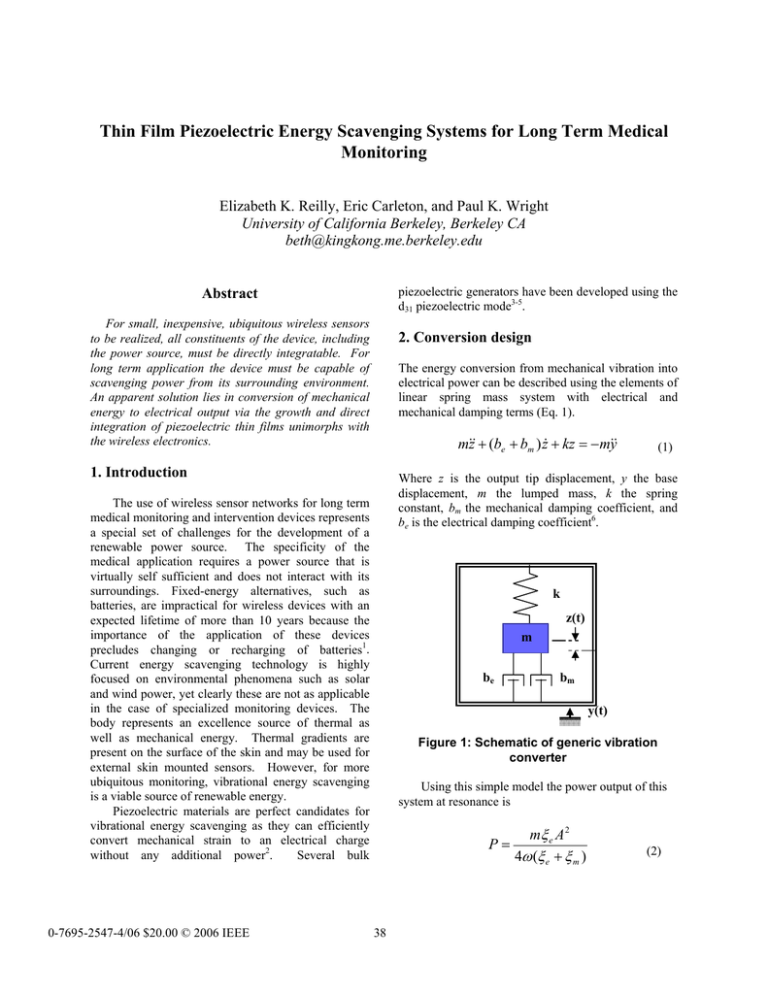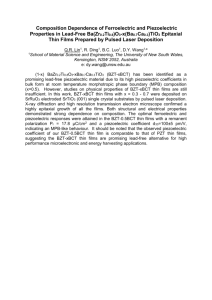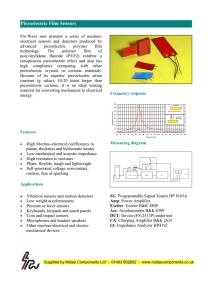Thin Film Piezoelectric Energy Scavenging Systems
advertisement

Thin Film Piezoelectric Energy Scavenging Systems for Long Term Medical Monitoring Elizabeth K. Reilly, Eric Carleton, and Paul K. Wright University of California Berkeley, Berkeley CA beth@kingkong.me.berkeley.edu piezoelectric generators have been developed using the d31 piezoelectric mode3-5. Abstract For small, inexpensive, ubiquitous wireless sensors to be realized, all constituents of the device, including the power source, must be directly integratable. For long term application the device must be capable of scavenging power from its surrounding environment. An apparent solution lies in conversion of mechanical energy to electrical output via the growth and direct integration of piezoelectric thin films unimorphs with the wireless electronics. 2. Conversion design The energy conversion from mechanical vibration into electrical power can be described using the elements of linear spring mass system with electrical and mechanical damping terms (Eq. 1). m&z& + (be + bm ) z& + kz = −m&y& 1. Introduction Where z is the output tip displacement, y the base displacement, m the lumped mass, k the spring constant, bm the mechanical damping coefficient, and be is the electrical damping coefficient6. The use of wireless sensor networks for long term medical monitoring and intervention devices represents a special set of challenges for the development of a renewable power source. The specificity of the medical application requires a power source that is virtually self sufficient and does not interact with its surroundings. Fixed-energy alternatives, such as batteries, are impractical for wireless devices with an expected lifetime of more than 10 years because the importance of the application of these devices precludes changing or recharging of batteries1. Current energy scavenging technology is highly focused on environmental phenomena such as solar and wind power, yet clearly these are not as applicable in the case of specialized monitoring devices. The body represents an excellence source of thermal as well as mechanical energy. Thermal gradients are present on the surface of the skin and may be used for external skin mounted sensors. However, for more ubiquitous monitoring, vibrational energy scavenging is a viable source of renewable energy. Piezoelectric materials are perfect candidates for vibrational energy scavenging as they can efficiently convert mechanical strain to an electrical charge Several bulk without any additional power2. 0-7695-2547-4/06 $20.00 © 2006 IEEE (1) k z(t) m be bm y(t) Figure 1: Schematic of generic vibration converter Using this simple model the power output of this system at resonance is P= 38 mξ e A 2 4ω (ξ e + ξ m ) (2) Where b=2mξωn and represents the relative damping ratio, A the acceleration input of the input vibration, and ω the operation frequency. The system should be designed so that they mechanically resonate at a frequency tuned with ambient vibration source in order to generate maximum electrical power. The scavengaeable power decreases by half is the applied frequency deviates 2% from the resonant frequency and is almost completely diminished if the frequency deviation is more than 5% from resonance.5 Considering the characteristics of the source vibration, the power decreases as frequency increases because the decreasing input vibration amplitude dominates the increasing frequency contribution. A study done by Roundy et al.2 shows that most of the available environmental vibrations are at lower frequencies. Therefore in order to maximize the power output the energy scavenging device should resonate at a frequency lower that 1 kHz. of the same composition. Also, epitaxial growth processes result in a very intimate contact with the electrode which can reduce both mechanical fatigue and cyclic depolarization. The requirement for all growth, fabrication, and integration steps to utilize standard microfabrication techniques necessitates the use of silicon wafer substrates and fabrication processes. Although the literature points to many methods for achieving growth of PZT on Si, most of these processes involve elaborate methods and multiple depositions of exotic buffer layers, most of which are not necessarily compatible with standard post-growth fabrication processes such as selective wet etching. An exciting alternative has been recently developed by Motorola [US Patent 2004] and involves the deposition of only one buffer layer, SrTiO3, which is an excellent growth template and allows for the growth of epitaxial PZT thin films. Using SRO as an electrode also allows the use of typical wet and dry etch fabrication processes, thus permitting a design based completely on standard microfabrication processes. Even assuming that a complete microfabrication process utilizing highly optimized epitaxial PZT thin films can be developed for the creation of energy scavenging devices, one still needs to determine if enough energy can be produced to power a nextgeneration wireless sensor node. The logical initial design would be one that is well known and characterized, has been shown to work in the past, and can be fabricated relatively easy with standard microfabrication processes, i.e. a simple heterogeneous bimorph, or cantilever. As mentioned previously, to effectively couple environmental vibrations, the structures must be designed to have a natural resonance that matches the environmental vibrations. The analytic model for the resonance frequency of a heterogeneous bimorph consisting solely of an elastic layer and a piezoelectric layer is shown as a function of length by Figure 2. It shows that small structures such as the microcantilever beams have relatively high resonance frequencies due to the 1/L2 dependency. The constituent tensor equations for a heterogeneous bimorph were derived by Smits et al.7, and can be solved to determine the voltage output resulting from an applied tip force. Although the model is very simplistic in nature, as it does not consider resonance, vibrational amplitude coupling, or power circuit coupling, it does give a decent approximation of how much power an array of 3. Device design considerations The ultimate goal of energy scavenging devices for medical monitoring is the realization of a completely integrated, microfabricated sensor node. To create an ubiquitous device of this nature requires careful consideration of a number of materials and processing difficulties, each of which predicate certain constraints on the materials selection and processing. Specifically, the concerns are: 1) the piezoelectric material must have sufficient material properties to produce a useable voltage under strain and have an intimate crystallographic and interfacial contact with the electrodes and growth substrate; 2) the growth, fabrication, and integration of the power source must consist solely of standard microfabrication processes; 3) the design of the energy scavenging device (with optimized piezoelectric layers) must be able to produce sufficient voltage under ambient vibrational excitation. Although many piezoelectric materials exist and are commercially available as thin films (thickness on the order of 1 micron), few of them exhibit large enough piezoelectric coefficients to generate appreciable voltage while under strain. The Pb(Zr,Ti)O3 (PZT) family of piezoelectrics in general have large piezoelectric coefficients and can be grown epitaxially with careful selection of growth substrate and electrodes (typically oxide electrodes, such as SrRuO3 (SRO) and LaSr0.5Co0.5O3 (LSCO)). Epitaxial, or pseudo-single crystal, thin films are attractive because the piezoelectric coefficients, mechanical constants, and dielectric properties of the films can be an order of magnitude higher than polycrystalline films 0-7695-2547-4/06 $20.00 © 2006 IEEE 39 cantilever beams could be expected to generate. power radios, this model may be on the lower estimation side and is located in its entirety elsewhere7. Trapezoidal cantilever shapes could easily be fabricated and would increase the generated power and cross-hatching would result in a more efficient use of the area. The optimal elastic/piezoelectric thickness and ratio were not used; instead, the dimensions and ratios that we are currently fabricating were used. Also, with slightly more elaborate, but still standard, microfabrication processes a proof mass may be added to the end of the cantilever beams to increase deflection and hence power output. 4. Fabrication Process The PZT (PbZr0.47Ti0.53O3) film was grown on a Si/STO substrate via pulsed laser deposition.8 Pulsed laser deposition was chosen for its ability to rapidly produce quality films. The quality of the piezoelectric films was determined through measurement of piezoelectric coefficient and remnant polarization. The d33 was determined using piezoforce microscopy and the results are located in Figure 4. It can be seen that the d33 value of the film is approximately 160 pm/V which approaches the bulk value. The polarization hysteresis curve identifies the saturation polarization and remnant polarization as 25 and 15 μC/cm2 respectively. These values continue to increase as the film fabrication is optimized. It should be noted the fabrication processes used to apply surface electrode causes a significant amount of damage to the surface of the film, as seen by the roundness of the hysteresis curve, therefore care must be taken while fabricating Figure 2: Resonance frequency of thin film cantilever The analytical solution for power generation from an independent piezoelectric cantilever assuming capacitive circuit coupling has been calculated elsewhere3. Assuming an epitaxial PZT piezoelectric coefficient, cantilever dimensions with a calculated resonance frequency of 800 Hz, typical (not optimized) elastic/piezoelectric thickness and ratio, and simple capacitive circuit power coupling, we calculate that each microcantilever beam can generate approximately 5.5 nW (Figure 3). Considering cantilever dimensions, we arrive at an areal power density of 5 μW/cm2, and an area projected volume power density of 80 μW/cm3. 6 200 150 100 4 d33 (pm/V) Power Output (nW) 5 3 2 50 0 -50 -100 1 -150 0 0 500 1000 1500 -200 2000 -15 Frequency (Hz) -5 0 5 Voltage (V) the cantilever structures. Figure 3: Estimated power output Figure 4: d33 measurement Although this calculated power density is at the threshold of the estimated required power for most low 0-7695-2547-4/06 $20.00 © 2006 IEEE -10 40 10 15 The initial fabrication attempts have been successful and work has begun to characterize power output and behavior of the devices. These devices represent an exciting advancement of the application of piezoelectrics in microscale energy scavenging. 30 Polarization (μC/cm2) 20 10 0 6. References -10 [1] Roundy, S. et al. “Improving Power Ouput for VibrationBased Energy Scavengers”, IEEE Pervasive Computing, vol. 4, no. 1, January-March 2005, pp. 28-36. -20 -30 -15 -10 -5 0 5 10 15 [2] Roundy, S. Wright. P. and Rabaey, J., “A study of low level vibrations as a power source for wireless sensor nodes,” Comput. Commun., vol 26., 2003, pp.1131-1144. Voltage (V) Figure 5: Polarization measurement [3] Glenn-Jones, P., Beeby, S., and White, N., “Towards a piezoelectric vibration-powered microgenerator, IEE Proc. Sci., Meas. Technol., vol. 148, 2001, 69-72. Thermal deposition of several thin Au/Pd layers (of varying thicknesses) functions to reduce the residual stress in the film as well as act as a top electrode layer. Arrays of varying length SRO/PZT/SRO cantilever beams were patterned and [4] Kymissis, J. et. al., “Parasitic power harvesting is in shoes,” Proceedings of the Second IEEE International Conference on Wearable Computing ISWC, Pittsburg, PA, USA 1998 approaching the power requirement for most low power radios. [5] Jeon. et. al. “MEMS power generator with transverse mode thin film PZT,” Sensors and Actuators A. in press 2005 [6] Williams, C., and Yates, R., “Analysis of a micro electric generator for microsystems,” Sensors and Actuators, vol. 52, 1996, 8-11. [7] Smits. et al. “The constituent equations of piezoelectric heterogeneous bimorphs,” IEEE Trans. Ultrason. Ferroelec. Freq. Control, vol. 38, no. 3, 1991, 256-270 Figure 6: Cantilever array: a) top view, b) at 45o [8] Reilly, E. Design and Fabrication of a Thin Film Piezoelectric Vibrational Energy Scavenging System, Masters Thesis, University of California Berkeley, Berkeley CA, 2004 dry etched using standard microfabrication processes and released using gasesous XeF2 etch. The structures have adequate robustness and can withstand vibrational accelerations on the order of several g’s. Testing is currently underway to determine output power at various input vibrations. 5. Conclusions Thin film PZT has been grown epitaxially on silicon with a limited number of oxide buffer layers. The film shows good polarization and switching capabilities. The residual stress that commonly plaques MEMS devices has been compensated for using a combination of metallic layers and careful processing techniques. Preliminary power modeling shows a minimum power density of 80 μW/cm3, 0-7695-2547-4/06 $20.00 © 2006 IEEE 41






